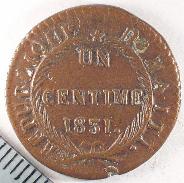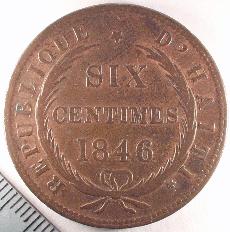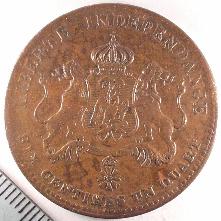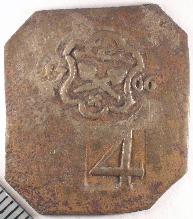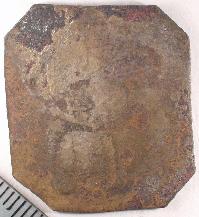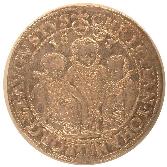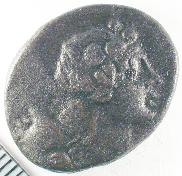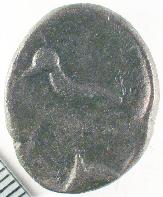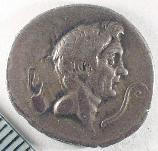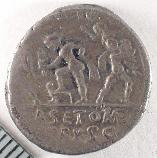Chatter
archive
also available
| Chicago Coin Club |
|---|
| Volume 49 No. 7 |
July 2003 |
|---|
Minutes of the 1014th Meeting
The 1014th meeting of the Chicago Coin Club was called to order
in the BankOne Building at 7 PM by President Mark Wieclaw
with 19 members and guests present.
The minutes of the April and May meetings were approved
as published in the Chatter.
Steve Zitowsky delivered an abbreviated Treasurer’s Report,
and provided the following after the meeting
| TCF Checking Account |
$2,093.52 |
| Bank One CD |
1,456.01 |
| Bank One CD |
1,457.39 |
| Dreyfus Money Market |
1,867.09 |
| TOTAL |
$6,988.31 |
It was announced that member Richard Peterson passed away
and a moment of silence was observed.
Guests for the evening were Roy Grundy, Gale Pewitt, George Wilson,
Richard Hlavacik and James Speicher.
Jeff Rosinia, 2nd V.P., introduced the speaker for the evening,
Steve Feller from Cedar Rapids, Iowa who spoke on the subject
Newly Discovered Facts about Confederate Coinage.
Afterwards, Jeff presented Steve with an engraved medal from the Club
and an educational certificate from the American Numismatic Association.
Exhibitors for the evening were:
-
Robert Leonard: 1861-O half dollar with the Confederate Obverse,
18th edition Standard Catalog listing mintages by Confederacy,
2-volumes of Byzantine Numismatic Bibliography, by Joel Malters
with unflattering comments about Al Oikonomedes.
-
Donald Dool: 1766 Schopfleim 4 kreuzer, 1831 Haitian un-centime,
1846 6 centime and 1850 6 ¼ centime.
-
Steve Huber: a book on European lines of succession,
a letter of introduction with 100 one-dollar bills,
and five German talers.
-
Carl Wolf: framed primitive money k’a k’im,
a silver ingot currency from northern Siam made between 1296-1556
but circulated into the 18th century.
-
Gale Pewitt: $5.00 note by Columbus Iron Works, Georgia,
manufacturers of 2 Confederate States of America ironclads
and signed by S. Warner, plant manager.
-
Mark Wieclaw: ancient Roman denarius of Sextus Pompey,
a double-struck ancient Greek coin and a 1996-W Roosevelt dime.
-
Steve Feller: one mark note issued 1944 from the
Mauthausen Concentration Camp, Austria, one of the most infamous death camps
of World War II.
Following the second readings of applications from
Chuck Jacobs, Ewa Tokarski and Matyga Ianina, they were voted into membership.
It was announced that Lyle Daly’s application for life membership was accepted.
Lyle Daly announced that he had checked into several additional restaurants
for the annual banquet.
After a discussion, the membership voted to hold the annual banquet
at Marcello’s, 645 West North Avenue,
Chicago and Lyle volunteered to make the reservation.
Robert Leonard spoke of the sale progress of his book
California Pioneer Fractional Gold
and the upcoming publication of Dr. Saul Needleman’s book
The Use of God’s Name Jehovah on Coins, Medals and Tokens.
A motion was made and passed for the Club’s ballot
for the ANA election of officers to be cast for the two club members,
Gary Lewis for President and John Wilson for Governor.
A letter was read from member Chester Poderski who has been unable
to attend meetings in over a year.
An open discussion took place concerning the history
of the 1913 Liberty Head nickels and an announcement that four specimens
will be on exhibit at the upcoming Baltimore ANA Convention.
The meeting was recessed at 9:15 PM and will be resumed 11 AM,
June 28th at the MidAmerica Coin Expo, Donald Stevens Convention Center,
5555 North River Road, Rosement.
. . . . .
The second session of the 1014th meeting was called to order
by President Mark Wieclaw at 11 AM in Room 5,
at the MidAmerica Coin Exposition, Donald Stephens Convention Center,
5555 N. River Road, Rosemont, IL. There were 16 member and guests present.
Guests were: Ray Dillard, Fenton, MI; David Harper, Iola, WI;
Chuck Wilkinson, Wheeling, IL; and Mark Borckardt, Mandeville, LA.
Kevin Foley, Convention Chairman, welcomed the attendees
and complimented the Club for its educational programs.
He went to say that he thought the Chicago Coin Club came closest
to what coin clubs were formed to do.
President Wieclaw called upon Carl Wolf to introduce the speaker, Mark Borckardt.
Mr. Borckardt, Bowers and Merena Gallery, spoke on the subject of the 1792 Half Disme.
He reviewed the current thinking that it’s now believed
to be a coin struck for circulation, not a pattern coin.
He cited the little literature that’s known from the records
of George Washington, Thomas Jefferson and Adam Eckfelt.
Borckardt went on to say he feels 3,500 were struck although
many believe that number is closer to 1,500 - 2,000.
Based on his professional experience, he feels there are 300
in existence today and maybe 12 are in mint state condition.
Concerning the subject of using Martha Washington silver to strike this coin,
Borckardt thought it unlikely.
Although records reveal that George Washington submitted "silver plate,"
Borckhardt said this meant silver bullion, something Washington would have easily possessed.
Speculation on the die engraver was also discussed.
After a series of questions, Carl Wolf presented Borckardt
with an engraved medal and an ANA Educational Certificate.
The meeting was adjourned at 11:45 AM
Respectfully Submitted,
Carl Wolf,
Acting Secretary
Richard E. "Dick" Peterson
Richard E. "Dick" Peterson, a veteran collector and show volunteer, died
June, 4 in Lake Placid, Fla., where he had lived 20 years.
He was 73.
A veteran of the U.S. Army during World War II, Peterson worked 20 years
as a draft engineer for Kaiser Engineers in his native Chicago.
Peterson began collecting coins while in his 20s and was an authority on Byzantine coins.
Over the years he worked as volunteer at numerous coin shows.
Most recently
he was floor manager for Central States Numismatic Society conventions.
He was a familiar site navigating the bourse floor on roller skates.
He previously was sergeant-at-arms for the Professional Numismatists Guild.
Peterson also was a member of the American Numismatic Association and the
Chicago Coin Club.
His other hobby was woodworking.
His daughter, Bets Hofsommer of Chicago,
said he was best known in Lake Placid for his
woodworking skills.
Survivors include his widow, Eileen, three daughters, his
mother, a sister and four grandchildren.
Funeral services and burial were June 6 in Lake Placid.
Cards can be mailed to 8 Tall Oaks Trail, Lake Placid FL
33852-8113
Jerry Lebo, Secretary/Treasurer of CSNS
. . . . . .
Richard "Dick" Peterson was an
excellent numismatist who contributed greatly in our numismatic hobby.
It was our pleasure to work with him at the Chicago International Coin Fair Conventions.
These conventions were first held downtown and later in Rosemont, IL., where
they are held today.
Dick was very friendly, personable, efficient and gracious.
He could solve a dealer / collector problem better then anyone we know.
Everyone who came to know him always came away liking him.
He was a great asset for PNG and we can remember how hard
he used to work during the PNG Day and later the changeover to the ANA Convention.
In recent years Dick worked for the CSNS conventions.
His great communication skills in solving problems and
dedicated work will be missed greatly by CICF and also CSNS.
His skills as a woodcarver were phenomenal.
No one could do it better.
Many times he brought examples of his work or photos of his work to the shows.
He was very proud of the carvings he did.
He always told us he couldn't keep up with the demand for his wood carvings.
His gentleness and friendliness will be missed by everyone who came to know him.
All of our prayers and thoughts to his wife Eileen and family.
Rest in Peace Dick, we will always remember you.
John and Nancy Wilson, Ocala, FL.
Speaker's Wor[l]d
A Current Look at the Coinage of the Confederate States of America
Presented by Steve Feller to our June 11, 2003 meeting.
A physicist by training, Steve Feller likes American history
and he considers the Civil War most interesting.
Although the paper notes of the Confederacy are the well known pieces,
the coinage is not as well known - for a long time,
by even the most generous of definitions,
the total coinage bearing a Confederate legend amounted to no more than $2.12.
Four genuine specimens are known of the 1861 New Orleans half dollar made from
an 1861 U.S. obverse and a Confederate reverse.
Steve showed pictures of the ANS specimen, one of the three in nice condition.
A well worn specimen, considered to be the pocket piece of Confederate
president Jefferson Davis, is in the John Ford collection
and some comments were made as to when it might come on the market.
Twelve copper-nickel cents appeared some years after the Civil War;
allegedly struck in Philadelphia in 1861 under contract to the Confederacy
before the main fighting started;
then quietly set aside once the fighting started;
and they were "remembered" after the Civil War, when any trading with the enemy furor
had diminished.
But not everyone was as circumspect about trading with the South,
as Steve demonstrated by showing $100 and $500 notes of Montgomery,
printed by the American Bank Note Company in New York.
As an example of the many notes printed by the U.S.,
Steve showed a $5 demand note;
the green ink used to print its back side gave rise to a nickname still
in use today: the greenback.
A lesser-known nickname for Confederate notes was blueback,
due to the blue ink used on the back side of some later notes.
At that time, gold was the benchmark against which everything else was measured,
and Steve showed a graph of the values of the U.S. and Confederate paper dollars
through April, 1865 (in the New York and Richmond, respectively),
by which time the Confederate dollar was worth zero.
Although they sometimes moved in opposite directions because one side's gain
usually was a setback for the other side,
sometimes they both fell in value.
At its lowest the U.S. dollar fell under 40 cents,
and it ended the war at about 70 cents.
Having reviewed the more widely known numismatic facts of the Civil War,
Steve moved on to the many gold and silver coins minted by the southern
states and Confederacy in the three southern mints.
These coins were minted using standard U.S. dies, so the classification
of a particular piece as U.S. or Confederate usually is complicated,
due to the use of variety and die state information.
The 1861-O Liberty Seated half dollars were produced from six obverse
dies sent to New Orleans in late 1860,
and six reverse dies left unused from 1860.
Research by Wiley and Bugert,
presented in their 1993 Liberty Seated Half Dollar book,
identified coins with all of those dies
and produced a emission sequence identifying 14 marriages.
The U.S. ran the mint until either late January or early February of 1861,
at which time it was taken over and operated by the state of Louisiana;
next, it was operated by the Confederate government
until its closing on April 30, 1861.
Wiley and Bugert believe the first three die marriages were made under the U.S.,
the next seven marriges under Louisiana,
and the last six marriages (the Confederate reverse, four marriages,
and one remarriage) under the Confederacy.
Although some of the dates and quantities for half dollars first presented by Breen
were changed by Wiley and Bugert,
Breen's opinions on the 1861-O $20 gold pieces still stand:
only one pair of dies was used to produce 17,741 coins;
5,000 by the U.S.,
9,750 by Louisiana,
and 2,991 by the Confederacy.
According to Breen, the coins with the greatest weakness in the date (a late die state)
were struck by the Confederates.
Although Louisiana left the Union on January 30, 1861,
Georgia did not leave until later;
therefore the mint at Dahlonega operated as a U.S. mint
longer than the mint at New Orleans.
The $5 coins were struck by both sides in 1861, but only the Confederates
struck the $1 coin.
Because North Carolina did not leave the Union until May, 1861,
most of the $5 coins were struck under the U.S.;
but some of those coins might have been struck by the Confederates.
In addition to the 1861 dies used to strike the above coins,
mint records show that other 1861 dies had been sent to the southern mints.
They are:
| 1861-O |
dime |
2 dies |
| 1861-O |
$2½ |
4 obverse dies |
| 1861-C |
$2½ |
2 obverse dies |
| 1861-D |
$2½ |
2 obverse dies |
However, no such coins have been observed, yet.
Speaker's Wor[l]d
First Issues of the U.S. Mint
Presented by Mark Borckardt to our June 28, 2003 meeting
held at the MidAmerica Coin Expo.
Mark started by asking two questions of the members:
"Have you heard of the 1792 half disme?" and,
"Is it a pattern or a regular coin?"
Then he briefly discussed the various pronunciations people use for disme.
Some people like the current pronunciation of "dime,"
some use "diz-muh,"
but Mark now likes "deem"
and that is what he used during his presentation.
Not much of what is generally accepted about the half dismes
is backed up with first hand evidence.
The records from that time are incomplete and provide spotty coverage;
Mark is still looking for an explicit newspaper or diary entry referring to the coins.
What facts and numbers are available are sufficiently vague or circumstantial enough
to be made to support any of a number of views of these coins.
Some of the speculation that has enterred the record over time
is unsupported or now is in conflict with new developments.
The most commonly cited reference to these coins does not mention
them by name.
Similar to today's State of the Union address,
George Washington's address of November 6, 1792 included comments on U.S. coinage:
"... measures have been taken ... others employed at home ... a small
beginning of the coinage ..."
The only other contemporary document that could be connected
to the 1792 half dismes is a July 13 entry in the personal account book
of Thomas Jefferson which Mark says corresponds to 1500 of the coins.
The next reference is from Jonas McClintock in an 1842 mint document,
where he states that Adam Eckfeldt had informed him that $100 of them had been produced.
Some years later, Mint Director Snowden called them Washingtom half dismes,
said they bore Martha Washington's likeness,
and came from Washington's plate.
Numismatic tradition holds that George Washington provided the silver for 2000 pieces
($100 in face value) by depositing some of his wife's silverware.
Mark takes issue with that, not certain how a man who takes his wife's
silver to be melted can stay married.
The confusion can be traced to the term "silver plate" which now means silverware,
but at that time referred to silver bullion.
To the thought that Martha Washington was the model for the representation
of Liberty on the coin, Mark again uses the enduring Washington marriage
as proof that the crude and hideous figure was not then attributed to Martha Washington.
Stewart's 1920s history of the U.S. mint includes an illustration,
based upon a painting commissioned by Stewart,
of the examination of the first coins minted.
The setting, although having a press off to one side,
could not possibly be the cellar of anyone's home.
It is generally accepted that the half dismes were produced in the cellar
of Mr. John Harper's home, before the first mint facility was completed;
that agrees with the "employed at home" part of Washington's address.
Tthere is no record of who engraved the dies for the 1792 half dimes.
The Birch cent has a similar style, so maybe the same engraver executed both.
John Wright prepared dies for the 1792 pattern quarter dollar,
but its style is very different from that of the half disme.
Voight and Eckfeldt worked at the mint, but never higher than coiner.
Maybe they were produced by John Harper,
who some think produced the dies for the 1795 Jefferson head Large Cent.
The general consensus now places the total mintage
of 1792 half dismes in the 1,500 to 2,000 range,
and that agrees with the Jefferson and Washington sources
if they were two views of the one major striking of half dismes.
But Mark believes that the two reports refer to separate strikings,
so the actual production was more like 3,500.
At one time, only 20 to 30 pieces were thought to still exist.
Now, Mark feels that 300 1792 half dismes still exist.
About ten percent of the original mintages of the 1796 Quarter Eagles
and the 1796 Half Eagles still exist;
applying that same rate to the 3,500 yields a number not far
from Mark's 300 estimated survivors.
But not all denominations survived at the same rate.
The 600 of the 1793 Liberty Cap large cents now thought to exist
indicate a 6% survival rate,
but at one time, the general survival rate for large cents was thought to be 3%.
Applying a plausible 15% survival rate to a total mintage of 2,000 also yields 300 survivors,
so the same number of survivors could be used to justify a number of different conclusion.
Mark and other serious students of the early mint continue the search
for more primary information, to fill in the gaps
and provide a better foundation for our opinions.
Show and Tell
Each image has a scale in the lower-left corner,
with the tics spaced 1 mm apart.
Because the brightness and contrast were manipulated on a computer,
the coloring of a coin's image differs from the coin's actual coloring.
-
Bob Leonard
started with a coin to complement Steve Feller's talk,
an 1861-O half dollar.
Although worn, it can be identified as one of the varieties
generally accepted as being struck by the Confederacy.
He followed that with Joel Malter's 2-volume
Byzantine Numismatic Bibliography (1950-1965, 1966-1994),
and quoted comments from the second volume about
Al Oikonomedes, who had reprinted with the first volume without Malter's permission.
(Oikonomedes operated a press specializing in numismatics reprints,
and he had also printed our club's
Perspectives in Numismatics
some years ago.)
-
Don Dool
showed coins from his liberty cap type collection;
all of the Haitian, and an unidentified piece.
Haiti broke from France in 1804;
for the next 40 years it bounced between a republic and empire
as can be seen from the legends on Don's coins.
-
1831 1 centime (Republic); note that the "28" on the obverse
refers to the 28th year of independence from France.
-
1846 6 centime (Republic) from year 43.
-
1850 6 1/4 centime (Empire).
-
This 1766 dated brass token was bought at CICF,
because of the apparent liberty caps on crossed poles.
However, they might be crossed shovels.
Don suspects he will never know more about it,
but is open to any suggestions.
-
Steve Huber
showed the new book
Lines of Succession
which he finds very handy in following European lineages.
Next was a sample modern day "token" sent to his New Jersey office.
His main exhibit was six large German silver coins:
-
1719 1 taler of Stohlenburg; a one-year type.
-
1595 1 taler of Saxony, featuring three brothers of the ruling family.
-
1630 double taler commemmorating the centennial of the Augsburg Confession.
-
1630 1 taler as above.
-
1711 1 taler of saxony, featuring the king on horseback.
This piece was in the Brand collection.
-
1763 1 taler of Saxony, used in both Poland and Saxony.
-
Carl Wolf
continued his exhibit theme of framed primitive money with k'a k'im,
a 900+ fine silver "broken bracelet" shpaed ingot issued by the Lannathai
kingdom (northern Siam) during 1296 - 1556 AD.
It held a value of one tamlung or four baht
and circulated into the 18th century,
preceding packsaddle money Carl had shown previously.
-
Gale Pewitt
showed a $5 note from the Columbus Iron Works,
which had produced two iron clads, the Jackson
and Chatahoochie, for the South.
He also mentioned how they were destroyed.
-
Mark Wieclaw
started with some ancient coins,
and concluded with thoughts on a modern coin.
-
A double struck coin of Thesalonika (187-131),
with two heads on the obverse and two stags on the reverse.
There was some discussion as to which of the strikes was made first.
-
A denarius of Sextus Pompey (42-40 BC),
showing the head of Pompey the Great on the obverse
and Neptune standing on a ship's prow,
flanked by the Catanean brothers, on the reverse.
-
A clipping from Numismatic News where the writer likes the 1996-W dime
but does not say why.
Mark also likes that coin, but was disappointed that no reason was given
in the piece.
He then cautioned everyone about buying the 1996 mint sets -- since the dime
is in its own little plastic pouch, verify that it is included
with any set that is purchased.
-
Steve Feller
showed some paper items:
-
August 1944 1 mark from the Mathausen Concentration Camp;
from an issue of 500,000.
-
A ration card for children.
-
A 50 mark note missing the overprint and serial number.
In answering a question, Steve mentioned that these were used by the inmates.
-
A postcard bought before the meeting at Harlan Berk's shop,
bearing the signature of physicist Robert A. Milliken
and mailed from Pasadena.
Chicago Coin Club Discussion Group
At the May meeting of the Chicago Coin Club I commented
that our agendas, which are interesting and informative,
do not allow for much interaction between members on an informal basis.
We discussed this again in June and well...
It's the first meeting of the Chicago Coin Club's new discussion group!
Where is it?
Our very own Bill Burd has kindly offered the use of his shop
- Chicago Coin Company, located ay 6455 W. Archer Avenue
- as the site of our first meeting.
We will discuss future meeting locations at this first gathering.
When is it?
We are trying the 4th Wednesday of every other month as a standing date.
The date of our first meeting is July 23.
The time is 6:30pm until 9:00pm.
Do not be concerned about arriving late or leaving early.
Just come! This is informal...
What's the topic?
Since we are meeting at Bill's shop and he has an impressive library,
we thought "Numismatic Research through books, computers, periodicals and auctions"
would be an appropriate topic.
Bill has agreed to moderate, but there is no speaker.
This is a roundtable discussion so bring your research project
or talk about what you would like to research!
-AND-
We will talk about future topics, where to hold these sessions
and what our format should be.
The intent is to add to the learning opportunities in the CCC
by beginning a series of group study sessions to discuss
topics of common interest to members & invited guests.
Some topics for consideration:
-
Methods of Cataloging a collection
-
Coinage of specific countries (pick one for the evening)
-
Specific designers and engravers (pick one for the evening)
-
Numismatic book discussion
-
Safes, desiccants, albums, safe deposit boxes
-
Coin "curating" or cleaning
-
Counterfeits and Coin doctoring
-
Non-competitive show and tell
-
Liquidating part or all of a collection
-
Experiences acquiring material
-
Security and the display of a collection
Now be patient with us!
This is our first session and we will be learning
how a discussion group will work in an informal setting.
Be flexible and bring your creativity.
Dinner!
There is an optional dinner at the Polish restaurant
next door to the Chicago Coin Company from 5:30pm to 6:30pm.
If you can make it, great!
R.S.V.P.
We have no idea how many members will attend.
See you there!
Lyle Daly
Our 1015th Meeting
| Date: | July 9, 2003 |
| Time: | 7:00 PM |
| Location: | Downtown Chicago.
Please remember the security measures at our meeting building:
give a club officer the names of all your guests prior to the meeting day;
and everyone must show their photo-ID at the security desk. |
| Featured speaker: |
Don Dool - Numismatic Finds of San Martin |
|
Don Dool recently returned from Argentina.
While visiting, he acquired over 30 additional numismatic San Martin items.
San Martin is a popular revolutionary,
and is the Liberator of Argentina, Chile, and Peru from Spanish rule.
Join Mr. Dool as he tells the story of San Martin
through medals, numismatic catalogs, photos of monuments,
catalogs, and newspapers.
|
Important Dates
| July |
9 |
CCC Meeting - Featured Speaker - Don Dool on Numismatic Finds of San Martin |
| |
| August |
13 |
CCC Meeting - Featured Speaker - Mike Metras on Early Trains on Obsolete Currency |
| |
| September |
10 |
CCC Meeting - Featured Speaker - Richard Hamilton on Stock Certicicates from Illinois Railroads |
| |
| October |
8 |
CCC Meeting - Featured Speaker - Robert Weinstein on Indo-Sasanian Coinage |
Birthday and Year Joined
| August |
2 |
William Swoger |
1984 |
| August |
11 |
Clifford Mishler |
1995 |
| August |
15 |
Steven R. Rodin |
1991 |
| August |
19 |
Carl F. Wolf |
1979 |
| August |
20 |
Melvyn Frear |
1989 |
| August |
26 |
Tom DeLorey |
1984 |
| August |
26 |
Donald H. Doswell |
1960 |
| August |
29 |
James M. Rondinelli |
1997 |
Chatter Matter
All correspondence pertaining to Club matters
should be addressed to the Secretary and mailed to:
CHICAGO COIN CLUB
P.O. Box 2301
CHICAGO, IL 60690
Visit Our Web Site
http://www.ChicagoCoinClub.org/
Contacting Your Editor
| Paul R. Hybert
|
| prhybert@worldnet.att.net |
Club Officers
| Mark Wieclaw | - President |
| Robert Feiler | - First Vice President |
| Jeff Rosinia | - Second Vice President |
| |
| Directors: | Lyle Daly
Mike Metras
Steve Zitowsky
Carl Wolf |
| |
| Other positions held are: |
| Robert Weinstein | - Secretary |
| Steve Zitowsky | - Treasurer |
| Paul Hybert | - Chatter Editor |
| Phil Carrigan | - Archivist |



